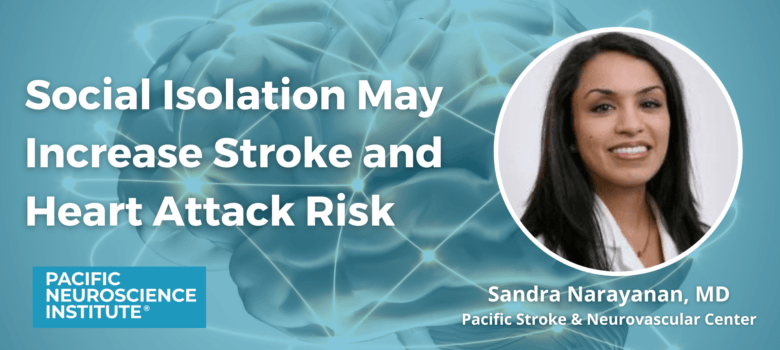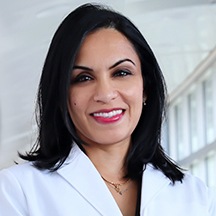

Social Isolation May Increase Stroke and Heart Attack Risk in Older Adults
by Amelia Garrison
Social isolation, characterized as infrequent interaction with others, may increase the risk of stroke and heart attack in older adults. Neurointerventional surgeon Sandra Narayanan of the Pacific Stroke and Neurovascular Center, explained.
Why is social engagement important for older adults?
Recent studies suggest that social isolation may increase the risk of stroke, heart attack, and Alzheimer’s disease in older adults.
Stroke, also called a “brain attack,” is caused when a blood vessel bringing blood and oxygen to the brain gets blocked or ruptures. When this happens, brain cells do not get the blood that they need. Deprived of oxygen, nerve cells stop working and die within minutes. The effects of stroke can be permanent depending primarily on where it occurs in the brain, and how long it takes to be treated.
The study, published in the Journal of the American Heart Association, found that social isolation can increase the risk of stroke by 23 percent and the risk of heart attack by 29 percent in older adults.
Social isolation was characterized as not having regular in-person social interactions with different groups, such as family, friends, and community groups, such as church and work colleagues.
Sandra Narayanan, MD, Vascular Neurologist and Neurointerventional Surgeon at the Pacific Stroke and Neurovascular Center at Pacific Neuroscience Institute, commented on how the outcome of the research may benefit patient diagnosis and treatment.
“The consequences of cumulative cardiovascular and cerebrovascular risk with social isolation at any age are too powerful to ignore,” she said.
“Healthcare providers need to be attuned to what is really important to our patients’ lives beyond laboratory values and metrics in order to improve quality and quantity of life,” Dr. Narayanan explained.
How common is social isolation?
Social isolation is prevalent in nearly one-fourth of adults over 65, affecting roughly between 33 and 47 perfect of older adults. Although social isolation increases with age due to a number of factors, including widowhood and retirement, research suggests that young adults between the ages of 18-22 are more socially isolated than former generations due to the prevalence of social media.

One such study found that adolescents and young adults who regularly use social media also suffer from depression, anxiety, sleep problems, substance abuse, and reduced cognitive control.
“This is compelling information for healthcare professionals seeking to connect with their patients and identify and treat loneliness and associated health habits, such as tobacco abuse and poor sleep hygiene,” Dr. Narayanan said.
What can family members do to include their loved ones in social engagements?
According to Dr. Narayanan, there are several steps that family members can take to reduce social isolation and loneliness for older family members. Although there are many different methods of approaching social inclusivity, the first step may be to acknowledge that your loved one’s situation is different than your own.
Dr. Narayanan explained. “Be welcoming and respectful of the older adult’s lived and current experience. Be cognizant of barriers limiting desire to participate (e.g. widowed or single status, being the odd person out, self-consciousness about joining younger groups with potentially different interests) or access to gatherings (e.g. limited mobility, unable to drive or access transportation, need to coordinate with medication schedules or other appointments).”

Hearing loss is also another consideration.
Taking the time to acknowledge that your loved ones may not be able to participate in social settings in the same way that you do, can open the door to innovative solutions for social inclusion. Once this happens, your loved one may be on the road to participating fully in family and community events.
Dr. Narayanan commented. “When feasible, bring the activities to the older adults to overcome barriers and to minimize absenteeism. As time passes and mutual engagement increases, desire to venture out with diverse groups may increase.”
How can older adults increase their engagement with others?
Acknowledging your risk for social isolation is the first step in improving your quality of life.
Dr. Narayanan explained. “Be open to trying new things, such as signing up for a class. Start small; a phone call, text, or note to reconnect with acquaintances and family. Come away from social interactions with a plan to increase engagement (if mutually desirable); make plans to follow up.”
If you are not socially engaged, consider reaching out to old acquaintances to rebuild your relationships or enjoy exercise with a group.
“Don’t assume that someone will continuously reach out to include you, especially if you’ve turned down social interactions in the past,” Dr. Narayanan said. “Take up a habitual form of physical exercise; it’s key to reducing cardiovascular risk and may bring one in contact with others that can serve as a coach or peer to help the individual support a healthy lifestyle.”
Article adapted from Healthline.
About Pacific Stroke & Neurovascular Center
Pacific Stroke and Neurovascular Center offers leading-edge treatments and nationally recognized care for all types of neurovascular disorders at four locations in southern California. Our comprehensive stroke centers are staffed by highly qualified and seasoned experts. Every stroke and neurovascular patient is seen by fellowship-trained neurovascular stroke specialists rather than generalists. You can be confident of your care in the experienced and capable hands of our team of neurointerventional surgeons, vascular neurologists and neurosurgeons.
Stroke Center & Neurovascular Locations
The Pacific Stroke and Neurovascular Center’s state-of-the-art facilities are located at:
Providence Saint John’s Health Center
2125 Arizona Ave, Santa Monica, CA 90404
310-829-8319
Providence Little Company of Mary Medical Center Torrance
4201 Torrance Blvd, Suite 520, Torrance, CA 90503
424-212-5340
Providence Saint Joseph Medical Center
501 S. Buena Vista Ave, Burbank, CA 90505
818-847-6049
Providence Holy Cross Medical Center
15031 Rinaldi St, Mission Hills, CA 91345
818-847-6570
About Dr. Sandra Narayanan

Sandra Narayanan, MD, FAHA, FANA, FSVIN, is board-certified in neurology and vascular neurology by the American Board of Psychiatry and Neurology and CAST (Committee on Advanced Subspecialty Training)-certified in neuroendovascular surgery. She is a vascular neurologist and neurointerventional surgeon at Pacific Stroke & Neurovascular Center, Pacific Neuroscience Institute. Dr. Narayanan’s professional and research interests include stroke systems of care, cerebral venous sinus stenosis, quality improvement in neurointervention, and radiation safety.
About the Author

Amelia Garrison
Amelia Garrison is the Marketing Specialist at Pacific Neuroscience Institute (PNI). Well versed in community outreach strategy and implementation, she leads the PNI blog, newsletter, and digital communications. Amelia oversees PNI's reputation management and community sponsorships.
Last updated: September 16th, 2022

